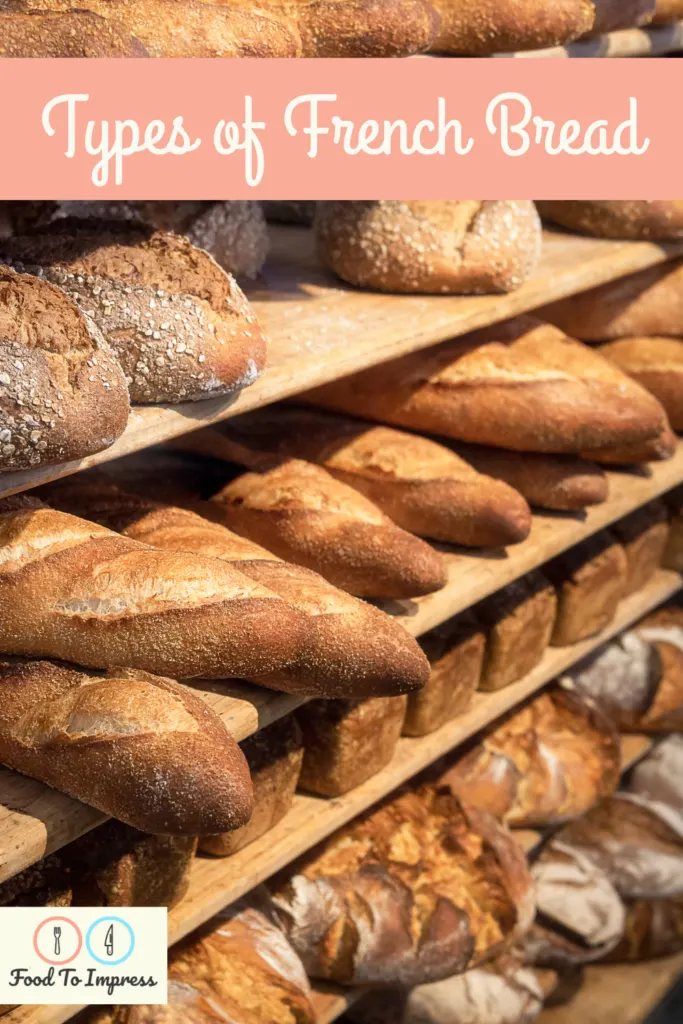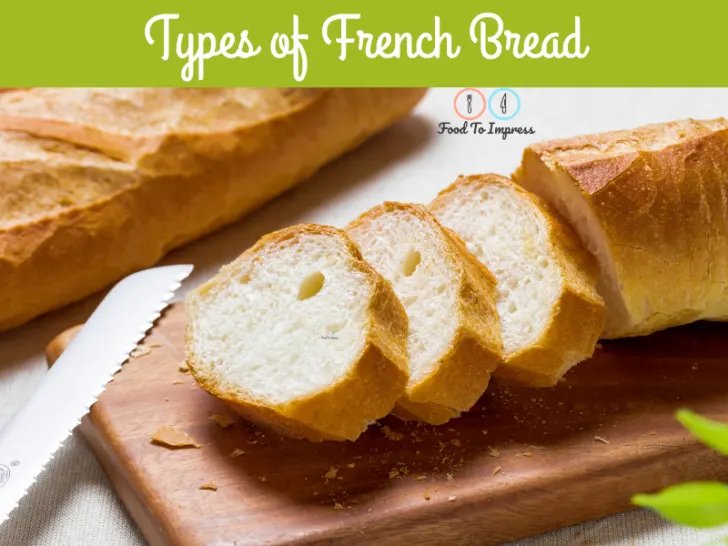French bread is a versatile ingredient to use when cooking and can be incorporated into many main dish recipes, appetizers, and desserts. Homemade French bread can also be enjoyed hot out of the oven with butter, served on the side of your favorite entree dish. Whether you choose to create a dish using different types of french bread or use it as a complement to a meal, you will find many delicious recipe options to suit just about any taste preference.
Types of French Bread
French bread is a staple of French cuisine and culture. Here are some of the most popular types of French bread:
- Baguette: A long, thin loaf of bread with a crispy crust and a soft, chewy interior. It’s the most iconic French bread and is often associated with France.
- Pain de Campagne: A country-style bread that’s made with a mix of whole wheat flour and white flour. It has a rustic, chewy texture and a nutty flavor.
- Ficelle: A thinner version of the baguette, ficelle means “string” in French. It’s similar in texture to a baguette but is smaller and often used for making sandwiches.
- Brioche: A rich, buttery bread that’s slightly sweet and often used for making pastries and desserts. It’s made with eggs, butter, and sugar, giving it a tender crumb and a shiny golden crust.
- Pain de Mie: A soft, white sandwich bread that’s sliced thin and used for making sandwiches, toast, and French toast. It’s a popular bread for children’s lunches and is often served with jam or Nutella.
- Pain au Levain: A sourdough bread that’s made with a natural yeast starter. It has a tangy flavor and a dense, chewy texture.
- Fougasse: A flatbread that’s shaped like a leaf or an ear of wheat. It’s often flavored with herbs, olives, or cheese and is served as an appetizer or as a side dish.
These are just a few examples of the many types of French bread that you can find in France or in French bakeries around the world.

The French Baguette Is A Staple Of French Cuisine And A Traditional Bread
Lovely and soft in the middle, crunchy on the outside, and with a smell that can’t be beaten, a freshly baked traditional french baguette is a delight.
Bread is a simple thing. Flour, water, some yeast, and salt, but what happens between start and finish makes a huge difference. The same ingredients make basic white bread, fluffy dinner rolls, or even natural sourdough. So how does a traditional baguette find its way through the fog?
The difference is in how the dough is treated. The brilliant chewy and moist interior comes from the kneading and a second rise while the wonderfully crisp crust from steaming the oven.
Kneading the dough for a long time will develop gluten which makes the dough elastic. It is practically impossible to over-knead dough destined to become a baguette. Once familiar with the process it becomes a matter of feel, however, 10-15 minutes of strong kneading is normally the target.
Rising the dough for two hours, punching it down, then allowing it to rise for another two hours creates the open texture of the classic baguette which is perfect for holding lovely little pockets of soft cheese, fresh mayonnaise, or anything one can dream up.
Tearing into a normal baguette (which just seems the right way to do it, leave the knife on the board), should make a sound akin to crumpling heavy cellophane; the top layer shattering rather than cracking. When the baguettes are ready to hit the oven, tossing a cup of water on a hot pan in the lowest rack position will create a steam bath which keeps the crust from forming too quickly. This allows the air pockets inside to expand and stretch in the standard baguette.
The Brioche Is The Best Choice
Brioche is a rich yeast-risen, cake-like, soft bread that can be eaten plain, or lightly toasted. It’s good cold or warm. Though rich, it isn’t sugary. French housewives and french bakers think of it as an all-purpose item. It can be breakfast bread, part of lunch or dinner when cooked with meat and vegetables, or the base of a dessert. I guess it’s the “petite robe noire” (little black dress) of the pastry family!
Plain or fancy, it’s a loaf of tasty bread. It can become dessert by adding a topping of custard, a bit of jam, fruit puree, ice cream, or mascarpone cheese. Be creative! This is why we take those long walks and do our exercises – to earn our Just French Desserts!
Croissant Is A Common Thing In A French Boulangerie
A croissant is a crescent shape, light, and fluffy roll traditionally made from puffed pastry that is usually also rather buttery. Croissants are a common breakfast food around the world and can be served alone, with toppings such as even more butter, sweet fillings, jams, jellies, cream cheese, fruit, or fruit preserves. Croissants can also be stuffed with items such as those listed above, cheese, or meat.
Although typically considered a French food as the name itself comes from the French word for “crescent” referring to the shape of the food, it is unknown if croissants are French. There are four widely accepted stories of the origins of croissants. One claims they were invented in 1683 in Vienna, and another says in Hungary. A third claims they were made at Maria Antoinette’s request in France for “Kipfel” an Austrian pastry. The last, and most commonly accepted story does agree that croissants are a French version of the Austrian pastry mentioned above created in the 1800s.
Croissants are generally considered on the more advanced side of the baking scale in french bakeries and the french home and can be a bit tricky to get right. Most recipes do call for basic bread ingredients including flour, eggs, yeast, butter, salt, sugar and warm water. However, the catch is these ingredients must be in perfect balance to create the unusual half pastry, half bread result that is the croissant.
Fougasse From The Northern France
The variants are so many, depending on the imagination of the baker and the tradition of the region. They are usually large size, rectangular, round, or elongated in shape, with large open cuts, but can be crown-shaped or star-shaped, and some versions are carved or cut in a pattern resembling an ear of wheat.
The fougasses are usually salty and are distributed mainly in the territory that corresponds to Occitania, although they also appear further north as the fouaisse or foisse from Burgundy and the foue or fouace from the Loire Valley. There is also a tradition of sweet fougasses, such as the fouace from the Rouergue region, the fouace from Nantes, the fougasse from Aigues-Mortes and the one from Arles, and the fougassette from Grasse, scented with orange blossoms.
Pain De Campagne Uses A Combination Of Flours
In France, pain de campagne or pain paysan (‘countryside bread’) is the modern generic name given to village country bread, those that are made in a traditional and artisan way in the small towns of the country by french families. This thin loaf of bread is usually made into round loaves, and are made with a mixture of rye and wheat white flour, or just whole wheat flour. The dough is left to ferment.
It began to refer to certain breads ‘de campagne’ in the second half of the 20th century with the industrialization of the French bakery. What was once the most consumed bread in France, fell into oblivion, being replaced by the baguette. The term encompasses rustic breads, with a bitter crust, especially those that met the flavor and characteristics of the bread of yesteryear. Curiously, “it is above all a city bread”.
For centuries, French villages had communal ovens where the townspeople brought their dough of the bread rolls to bake, and the loaves weighed from four to twelve pounds. Loaves this large and unique shape would feed a family for days or weeks, until the next baking day.
In the past (and it is still possible to find it in certain bakeries) the levain system was used, a preference without biological yeast. Recipes with rye flour add about 10% compared to wheat flour. It is believed that the addition of this food in some areas is because the rye grew wild among the wheat fields.
Types of French Bread – Faluche Has To Be On The List
Faluche, also known as “Le pain du Nord” (the bread of the North), is a type of bread typical of the Nord-Pas-de-Calais region, France, and the Tournai region of Belgium.
The bread is made from flour, yeast, a little milk, and olive oil. It has a peculiar shape, very white, imperfectly rounded, and flattened, resembling the homonymous hat that French students historically wore and from which it owes its name. In addition to standing out for its white color, it is dense on the inside and not on the outside. It is usually consumed freshly made as part of breakfast or as a snack, being served hot.
French bread is one of the most popular breads in the world. No wonder because it’s so versatile and has so many different shapes you can use it for everything from a Christmas dinner to sandwiches to crostini to soup. Plus, it’s easy to make at home!

